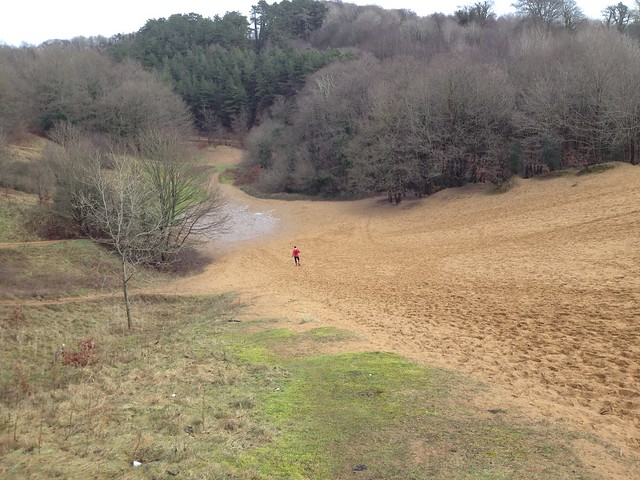
"Big Dipper" - Near Brigend, Wales
Marathon des Sables is not all big sand dunes, but there are a fair few of them. In 2012 stages 1-3 had a lot of dunettes, stage 4 had the major massive dune (be interested if it's in this year) plus dunes in the night, stage 5 was very variable in terms of terrain - sand here and there all throughout, and stage 6 had the major dunes which was tough.
I grew to hate the smaller cutely-named "dunettes" - longer, rolling sets of sandy kilometres. I found more challenging than the big guns because it was difficult to look forwards and see a point to focus on as a goal to reach, like the bigger dunes give you.
However, on the bright side, I don't remember finding the sand as troublesome as I thought I might. Yes it is difficult to run in, but as I walked most of the time, this wasn't an issue! Plus running down dunes is rather good fun.
To get the most out of yourself in a sandy environment you need to concentrate on two things - equipment and technique.
Equipment
You'll need gaiters. Obviously. If you've had your head buried in the sand (ho ho) gaiters are pieces of material (usually parachute silk) that cover your trainers and tie up around your calf to help prevent sand getting into your trainers, and thus lessening the chance of the dreaded blisters accuring.
I used Sandbaggers, which were wonderful. I velcroed them onto my trainers, then also gaffed taped them too.
An important tip to remember is to try out your gaiters before you go, to make sure they are "sandtight".
The other equipment consideration is walking poles. I did not take them, but ended up using a spare pair (unfortunately borrowed from a tent teammate who was pulled out of the race) to help with my ever-painful shin splints.
They were invaluable to me to help cope with the pain, but if I hadn't have suffered from shin splints I would have been fine without them. Having said that, poles do make a lot of difference getting up and down sand (and just anyway really). The toss up is whether you want to carry the extra weight or not.
You still have time to train with them now, but I would advise against getting them any closer to the race as you won't be used to using them.
Last year I would say roughly 15-25% had poles with them.
Technique
I found that you expend less energy and aren't actually much slower if you stick to walking up dunes.
Walking also means you have more time to locate the foot placement of the shuffler in front of you. Treading in the path of others is the best way to get up dunes, as the sand is already more compacted and stable.
I did a weekend in South Wales where the huge sand dunes are. Otherwise, just getting off road onto stony, muddy, hilly ground is great preparation for sand running too.

Do you know if any of the competitors in the top 50 used poles?
ReplyDeleteNot 100% sure but I would go with no they didn't. Poles used much for walking/shuffling. Top 50 are definitely running so poles would slow down/add weight.
Delete